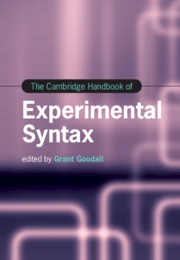Book contents
- The Cambridge Handbook of Experimental Syntax
- The Cambridge Handbook of Experimental Syntax
- Copyright page
- Contents
- Figures
- Tables
- Contributors
- Introduction
- Part I General Issues in Acceptability Experiments
- Part II Experimental Studies of Specific Phenomena
- Part III Experimental Studies of Specific Populations and Language Families
- Part IV Experimental Syntax beyond Acceptability
- 22 Theories All the Way Down
- 23 Eye-Tracking and Self-Paced Reading
- 24 Nothing Entirely New under the Sun: ERP Responses to Manipulations of Syntax
- 25 Corpus Studies of Syntax
- 26 Syntax and Speaking
- 27 Neuroimaging
- Index
- References
23 - Eye-Tracking and Self-Paced Reading
from Part IV - Experimental Syntax beyond Acceptability
Published online by Cambridge University Press: 16 December 2021
- The Cambridge Handbook of Experimental Syntax
- The Cambridge Handbook of Experimental Syntax
- Copyright page
- Contents
- Figures
- Tables
- Contributors
- Introduction
- Part I General Issues in Acceptability Experiments
- Part II Experimental Studies of Specific Phenomena
- Part III Experimental Studies of Specific Populations and Language Families
- Part IV Experimental Syntax beyond Acceptability
- 22 Theories All the Way Down
- 23 Eye-Tracking and Self-Paced Reading
- 24 Nothing Entirely New under the Sun: ERP Responses to Manipulations of Syntax
- 25 Corpus Studies of Syntax
- 26 Syntax and Speaking
- 27 Neuroimaging
- Index
- References
Summary
This chapter focuses on experimental psycholinguistic techniques that tap into real-time sentence processing by measuring moment-by-moment reading times or eye-gaze patterns. Data recorded during real-time reading or listening can provide implicit measures of grammatical sensitivity and are a valuable source of evidence for grammatical distinctions, operations, and constraints proposed within the theoretical linguistic literature. A selective review of recent reading-time and eye-movement monitoring studies illustrates how these techniques can help us investigate theoretical linguistic issues and hypotheses, and provide insights into the nature of syntactic derivations and representations. Charting comprehenders' sentence processing profiles over time can help reveal the sources of unacceptability and of grammatical illusions, the point in time at which grammatical violations are detected, the point in time at which grammatical constraints are applied, and can also reveal processing reflexes of a sentence's derivational history.
Keywords
- Type
- Chapter
- Information
- The Cambridge Handbook of Experimental Syntax , pp. 617 - 640Publisher: Cambridge University PressPrint publication year: 2021



